The early 90’s are an era that we here at Club 25 are obsessed with; a watershed time in the history of football shirts, simplicity was suddenly out of vogue and replaced of all manner of complex and convoluted patterns. Although the heedy heights of those days have mostly passed – with only a few clubs opting for zany shirts nowadays – you sometimes happen upon a shirt that truly blends the boundaries between a modern kit and something you’d expect to see in 1993. Today, we have one such example all the way from Thailand, with Bangkok United and Thai manufacturer Ari serving up something incredibly delightful;

You might think this is a particularly loopy ladybug, but it is very much an actual football shirt – unlike any other we’ve come across (and we have seen a fair few in our time!). Jagged blocks of black, which seem to fade out along their edges, cascade down th torso among an increasingly darkened background which goes from an attractive medium red at the shoulders to a reddish grey at the bottom hem. Coupled with red sleeves and red and black sidepanels, this is a shirt that demands attention and is bound to get people to put their heads on a swivel if you wear it while walking down the high street.
Whether they’d be in awe of your fashion sense or merely snickering at the eccentricity of this shirt is up for debate, but it can not be denied that this is a shirt unlike any other – and in a business where bog standard templates run rampant, the individuality espoused here is unequivocally a good thing. Behind this ladybug look we find the design team of Ari, a Thai brand not hitherto featured on this humble site, and Bangkok United, who become the latest Thai club to be featured in our reviews. Because this large Southeast Asian country is a reliable source of bespoke tops, we are proud to have built up a small repertoire of articles based on fiendishly outlandish tops, which you can consult via the links below;
- Angthong FC 2015 Home Shirt
- Big Bang Chula United 2016/2017 Home Shirt
- Chainat Hornbill 2018 Home Shirt
- Khonkaen F.C. 2014 Home Shirt
There are some gold nuggets in that list – a hot pink shirt with purple tiger stripes and a mighty fine gold/black chevron to name just two highlights – but we won’t delay matters any further; let us dive in and find out everything there is to know about this kit, Bangkok United, and suppliers Ari. Oh, and let us not forget to needlessly rattle on about all thirteen (yes, thirteen!!!) sponsors found here. And this won’t be the only Bangkok United shirt on the site either, as we will have the amazing 2021 shirts up for review in the near future courtesy of our friend Matt who kindly bought us a player version on one of his trips to Thailand.
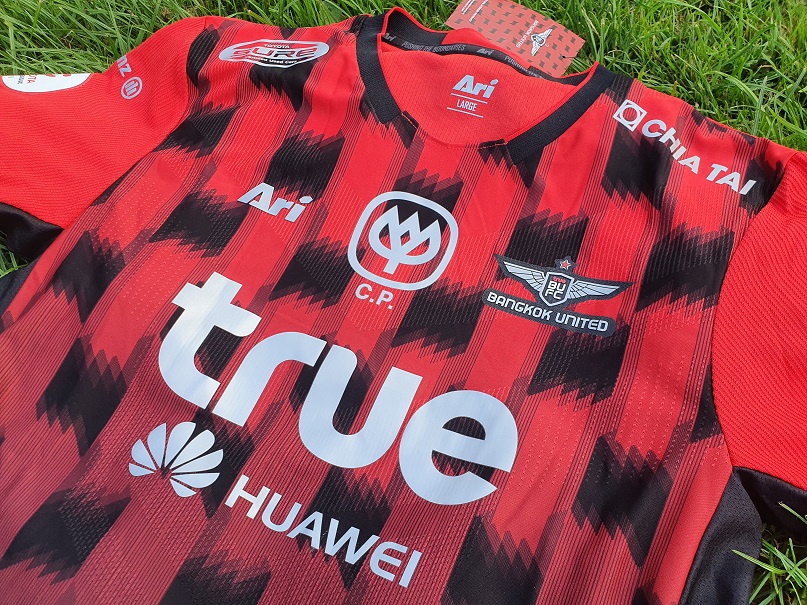
Our trademark diagonal shot of the chest brings us a little closer to the shirt, which reveals a feature you might have missed at first glance; an incredible degree of texturing in the fabric, with mesh, dots, and ventilation-related holes running across the torso and sleeves.
This is something that is increasingly rare to see on football shirts; most football clubs and suppliers don’t bother with creating a truly performative shirt beyond the archtypical breathable polyester, some mesh at the armpits, and fancy panelling to improve freedom of motion. For most clubs that you’d expect to see in the Champions League on the regular, the big three brands – Nike, adidas, and Puma – as well as a select few others like Kappa create two different specifications of shirts, with one featuring better material and cuts for use on the pitch and the other being a relaxed, cheap fit for fans to wear to the stadium or at home on the couch.
Where they didn’t use to participate in this somewhat dishonest practice, Thai brands like FBT and Ari have recently also gotten in on the fun by offering ‘stadium’/’cheer’/’fan’ shirts and player-spec shirts. This is slightly understandable as prices and profit margins are lower in countries like Thailand, with many fans having very little money to spare; for them, the cheaper replica shirts are a lifeline that helps them still support their local clubs despite the suppressed wages in this region of the world. Another reason why we don’t really get angry over the Thai brands offering two different types of shirts is the fact that where the price of the fan shirts converts to around 10 GBP, the player-spec kits typically only retail for double that – a stark contrast to clubs in England who, increasingly, charge 50 quid for a replica shirt.
Our Bangkok United shirt is player-spec, exactly as the team wore out on the pitch, and only cost us about a tenner via the end-of-season sale at Ari’s concept store in the Thai capital. An absolute steal at 395 Baht, and proof that the prices of football shirts in the West are outrageously expensive, and devoutly anti-consumer. There is no excuse charging upwards of a 100 pounds for a shirt with extra holes and better material, when Ari has proven with this shirt that you can get the ‘quality’ and ‘expertise’ of a Nike/adidas/Puma player-spec shirt for as little as 20 quid, brand spankin’ new in at the start of a season. Although, the fact that this is ‘only’ Bangkok United rather than, say, Liverpool or Juventus helps as club licenses have increased hand over fist in Europe to the point where even the big boys like Nike and adidas need to price-gouge to make a decent return on their investment.
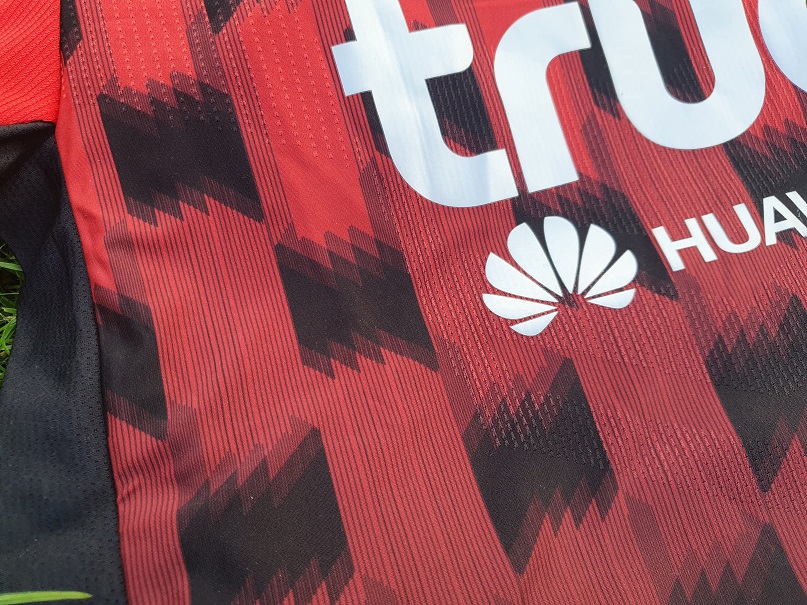
So, fine, this shirt proves those pesky Europeans are sadistic capitalists – but what about the design? Well, as we get even closer to the shirt we can see how, besides that fine texturing for sweat-wicking purposes, the jagged blocks of black have their fades created by thin lines that run from one block to the next. Observe how, from the deep, plain black, you can see fine lines arise that combine with the base red to create a slightly reddish hue, which is then doubled as the black is replaced with dark red. Finally, only a few of those dark red lines continue past the second stage of the fade, mixing with the medium red as they continue on to the next block of black.
This makes for a pattern that is really interconnected from one element to the next, whilst also ensuring that the lines and the way they build up/down create a fading effect of black going to red the higher up on the shirt you go.
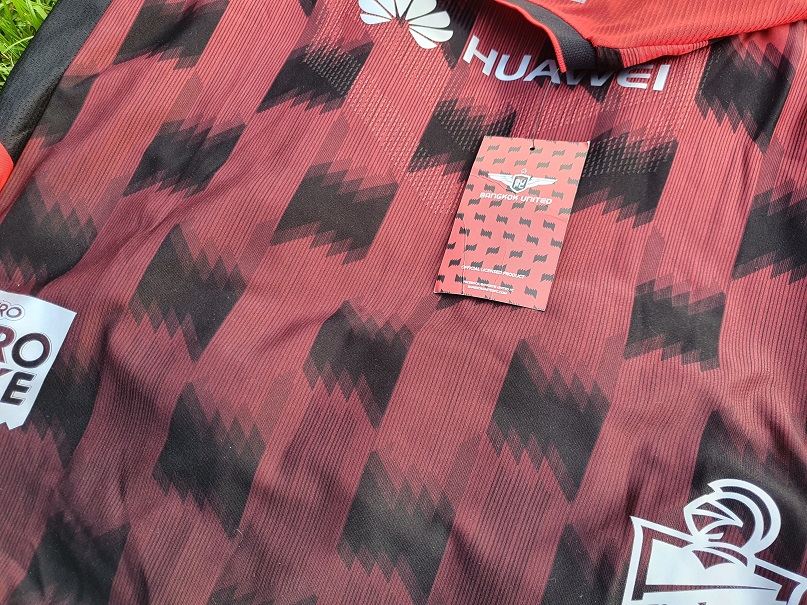
That fade is extra pronounced by how the black/dark red lines increase in girth the further down the shirt they are, which helps to keep the fade as natural as it can be (after all, this is a man-made design based on abstract, geometric shapes that you wouldn’t encounter in nature). You can observer the fade especially well in the above image, taken of the lower half of the shirt where the black becomes increasingly pronounced.
One simple if delightfully thoughtful detail is added in the form of the shirt’s pricetag; the blocks of black featured on the shirt are replicated on the cardboard, albeit without any kind of fade involved. This helps to showcase how just the pure black would look if all the fading was left out, although it’s a shame that this would be lost on most as the tag is, of course, often ripped off a shirt right away. God bless collectors like us preserving it for posterity’s sake, then!
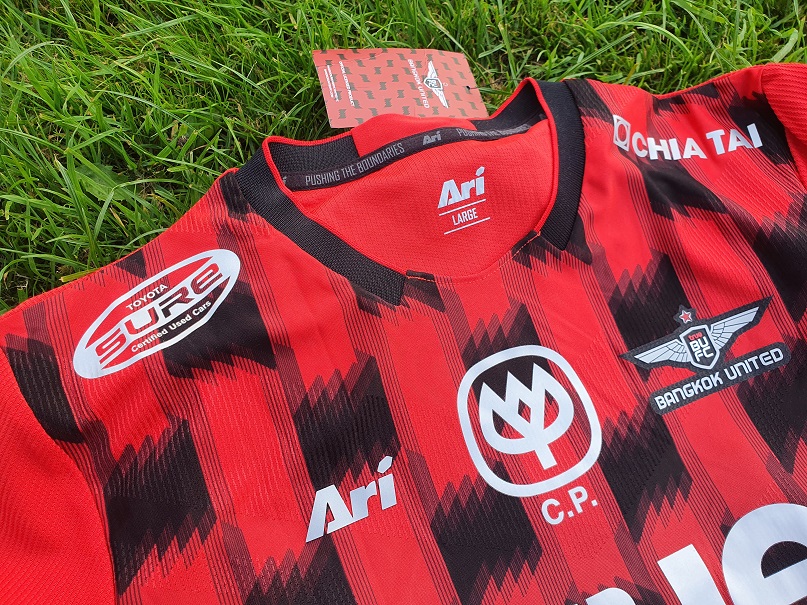
Compared to the darkened bottom half, the top is relatively clean – red dominates here, if even the lines have continued along the sides of the blocks of black. A simple, clean collar in black with red piping is provided to cap off the shirt, and its lack of iniative in trying to emulate the pattern is appreciated.
What is perhaps even better is the fact that, where some Thai shirts lose their way by letting sponsors bring in their corporate colours, Ari and Bangkok United have ensured that every single logo on the shirt is done up in the same attractive shade of silver. The result is a shirt that remains coherent as a whole despite the fact that it has an incredibly busy pattern coupled with an exercise in slapping as many sponsors on a single shirt as possible. It is likely that silver was chosen as a result of it being the tertiary colour of the club, in addition to the red and black.
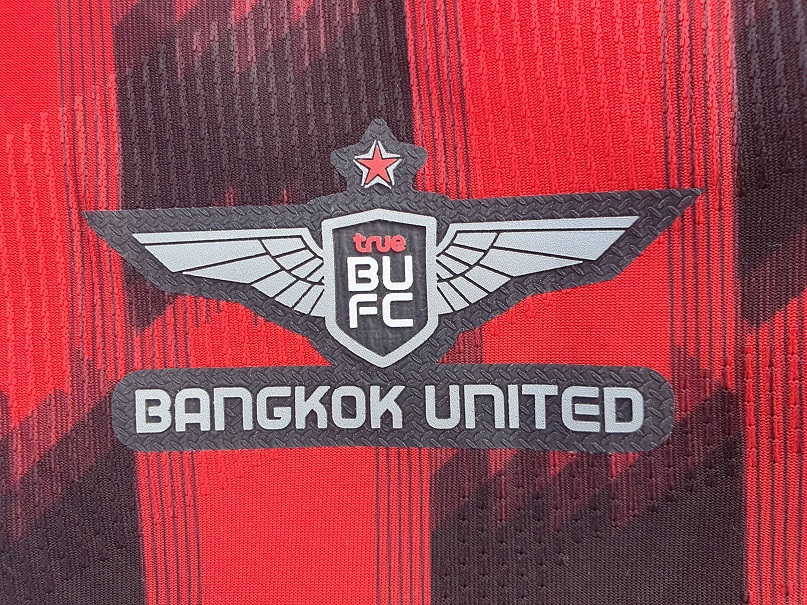
The material used for the club’s crest is somewhat odd, featuring the kind of anti-slip texture you’d expect on emergency stairs, but it does give this otherwise unremarkable logo a nice, industrial look. Helpful, when you consider that this is a tiny shield with the club’s initials, a set of wings, and the name sat underneath the rest.
Unsurprisingly known by the nickname of Angels, Bangkok United are one-time champions of Thailand and a stalwart of the country’s top flight; where Thai clubs are prone to spontaneous combustion and demotion to the amateurs (ask BBCU), United have only been relegated from the Thai League 1 once, being absent for just two seasons, since they first reached the top level of the pyramid in 2003. While their sole championship win came in 2006, when they were still known as Bangkok University FC, the support of their new owners has seen the club challenge for silverware in recent seasons with two second place finishes and a single third place from 2016 to 2018.
As the former name implies, this side was once the in-house team for Bangkok University, an institution of higher education that was founded in 1962 and had various loosely-organized football teams that played under its name until 1988 (2531 going by the Buddhist Calendar dominant in Thailand), when the university decided to run a single team in a more professional capacity. Bangkok University Football Club was born and officially registered with the Thai FA. Club colours were orange and purple, which totally coincidentally mirrored the university’s colours.
The team started life in the Ngor Royal Cup, the lowest level on the pyramid back then which featured illustrus clubs like, uh, Bangkok Bank of Commerce FC and Thai Tobacco Monopoly FC (aptly nicknamed สิงห์อมควัน / Cigarette smokers). The club was promoted to the third tier Khor Royal Cup in 1990, and then to the second tier Khǒr Royal Cup in 1991. Yes, we know what you are thinking; the third and second tiers were actually called Khor and Khǒr respectively, we are not joking. The club’s growth was then stunted by the stronger level of competition encountered in the second tier, with a breakthrough to the top tier not being realized until 2003 when they were crowned champions ahead of Royal Navy FC.
In the first two years of play in the top flight, the University team (which by now naturally included some professional players) confounded expectations by finishing 4th in 2004 and 7th in 2005, well ahead of the relegation zone. Bangkok then blew the entire country’s mind by winning the title in 2006, ahead Osotsapa FC (gone defunct and refounded since, this is Thailand after all) and BEC Tero Sesana (which somehow still exists, although as Police Tero FC). This qualified University to play in the AFC Champions League, where they got to contest memorable ties with South Korea’s Chunnam Dragons, Japan’s Kawasaki Frontale, and Indonesia’s Arema. Three losses and three draws saw Bangkok finish fourth in the group.
It soon became apparent that actual Bangkok University had taken the team as far as they could, with the won title perhaps being a fluke. So, in 2009, the University entered into a strategic partnership with the Bangkok municipality to not only maintain the club’s position in the top flight but further raise the bar in terms of football development. This move saw the club change from orange and purple to green and orange (the regional colours of the capital), as well as adapt the name Bangkok United to properly represent the entire city. This is a welcome bit of naming sensibility in a league that also featured the previously mentioned Tobacco Monopoly, a club named after a big bird, and the Swat Cats of Nakhon Ratchasima.
The partnership with the city itself didn’t turn out to be the impetus that would take the club to great new heights; rather, the introduction of the True Corporation as majority shareholder ahead of the 2010 season was. A telecom company, True owns Thailand’s largest cable TV channel, is the largest internet service provider, and one of the biggest mobile operators via its TrueMove brand, whilst being a subsidiary of the even larger Charoen Pokphand – which owns pretty much all of Thailand. So, naturally, this investment from one of the most powerful firms in Thailand surely resulted in instant success, right?
Nope. Bangkok United were promptly relegated. To their credit, True stayed on board, consolidated, and funded the club to the point where a return to the top flight was secured in 2012, with the club never being troubled by the prospect of relegation since. The current crest was first used without True’s name in 2014, with its wordmark eventually being added in 2017. The wings had no basis for being included beyond the club styling itself as Angels, whilst the lone star is, of course, in honour of that remarkable 2006 wherein the club was still a humble university-based side that created a footballing fairytale.
With the club’s history and current ownership structure known, the wordmark for True appearing on the chest is to be expected. Huawei appears as second billing, which isn’t a coincidence either; China Mobile, which is one of the technology giant’s principal partners, owns 18% of True so we imagine that Huawei’s name being featured here is the result of this corporate old boys network.
C.P. meanwhile is short for Charoen Pokphand, who own the main share of True and thus most of Bangkok United as well. They have a finger in most every industry in Thailand, and have a yearly revenue of upwards of 60 billion US Dollars. Just to give an indication of the scale we are dealing with here.

Compared to all those business heavyweights, Ari are a relatively small player. A football-specific company founded in Bangkok in 2009, this brand managed to fight its way into the big time throughout the past decade as it nestled itself in the top echelons of Thai football, sitting pretty besides older brands like Grand and FBT. This is not entirely dissimilar to Warrix, who themselves are also a relatively new supplier that has chipped away the marketshare of the established names.
While Ari have been supplying Bangkok United since 2014, the Angels are by no means the brand’s biggest deal; rather, that would be Buriram United, who allow Ari to produce shirts for use in continental competitions. This is a massive honour, as Buriram are very specific about their shirts and continue to produce their domestic-designated shirts in-house.
Other clubs that wear Ari include Samut Prakan Cityand Pattaya United, while Ratchaburi Mitr Phol and Sisaket have previously donned Bangkok-made kit. It’s a shame that we don’t have any other shirts produced by Ari, because we are very curious to see whether they are of the same high level of quality. Yes, the sponsor logos are all stickered on, but the fabric and fit used here really is a cut above what we are used to from certain European suppliers. Ari’s wordmark itself isn’t a sticker, by the way, but rather rubberized and stamped onto the shirt – we’d be biting our nails over the prospect of it washing off were this shirt ever to go into the washing machine.
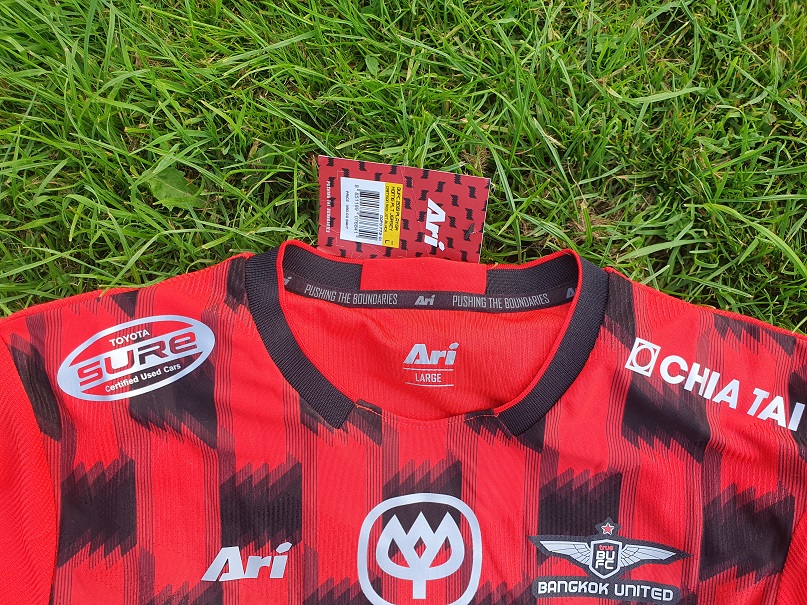
Ari’s wordmark also appears inside the collar, along with the simplest of sizing information as well as the brand’s motto; ‘pushing the boundaries’.
While collarbone sponsors have been common in Japan for a few years and recently even appeared in Singapore, Thailand has a long-standing tradition in terms of corporate partners appearing on this part of a shirt. In 2019, Bangkok United had Toyota Sure and Chia Tai appear; the former is a large chain of used car dealerships that has its outlets dot the nation’s capital, while the latter are an agricultural company that sells seeds and fertilizer. Of course, Chia Tai is owned by Charoen Pokphand but, and forgive us for making this joke, was actually the seed of this huge business empire as CP grew out of the initial seed business started in 1921.
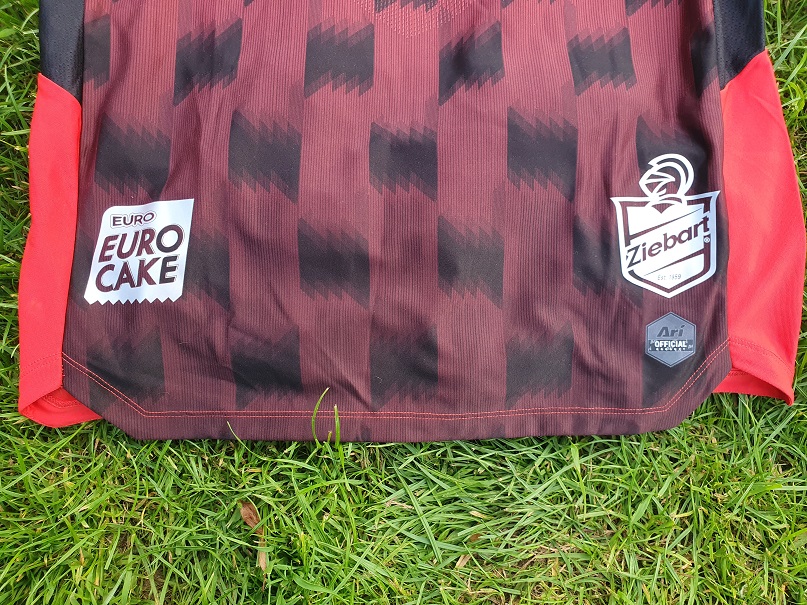
Jocktag sponsors are also common in Thailand, and we find two on this shirt; Euro Cake (styled as Euro Euro Cake) is a hugely popular range of sweet cakes and pastries that are sold by the thousands in Thailand’s many convenience stores (for a fun fact, look up how many 7-Elevens exist in Bangkok alone) and we can vouch for the quality and taste of their custard cakes from personal experience. They are not actually owned by Charoen Pokphand, but rather an independent business established in Samut Prakan in 1995.
Ziebart, meanwhile, is a car detailing and servicing business out of the American state of Michigan, which first expanded into Thailand in 2016. Its logo sits right above Ari’s ‘Official product’ patch. Be sure to pay some attention to the way the shirt’s bottom hem is shaped here, with the front panel being longer than the others and hooking diagonally upwards at its edges to join up with the sides. The reverse has a similar ‘hooked’ effect, ostensibly to improve the shirts form – bear in mind that this is a player shirt, and thus will lean heavily on features like this that you wouldn’t normally expect to find on stadium/cheer shirts.

We are pleased to note that we did not have to pay extra for the league patch, as it came applied to the shirt right out of the bag. That’s a lot of bang for your Baht, right there. Lot of sponsors too, the two sleeves are good for three further logos between them.
Allianz is a German insurance company and not that interesting in the context of this shirt, but the CP and CPall. The circular CP was previously seen on our Angthong shirt and represents Charoen Pokphand’s interests in the food sector, appearing prominently on its Fresh Mart grocery stores and individual products. CP All, meanwhile, is the umbrella company under which all Thai 7-Elevens are operated. When we opened this article with the notion that it had thirteen sponsors applied to it, all of whom agreed to forego corporate colours in favour of uniform silver, you as a reader might have thought this to have been a herculean accomplishment by Bangkok United’s commercial team. Now that we’ve covered ten of the sponsors and learnt that half of these, as well as the club itself, are owned by one single monolithic company, it seems slightly less impressive.
That league patch is hardly anything to write home about either, being a rather poor, thin sticker; you can see the texture of the shirt’s fabric appear from underneath it. The logo, a stylized ‘T’ with a dot might appear to be a footballer kicking a ball – or, if you look closely, an elephant. No prize for guessing what the country’s mascot animal is. The 2019 applied to the patch is reminiscent of the way things are handled in Hong Kong, and helps to date the shirt where a layman would otherwise have a hard time affixing a specific season to this design. In a display of restraint that proves to be the polar opposite of the shirt’s front, the sleeves are plain red with simple black, stretchy fabric at the cuffs.

Onto the back, where we find our final three sponsors for today, as well as a better look at the stunning performance-enhacing texturing on the shirt; built up in chevrons of varying widths, tiny holes have been punched through the fabric to increase the degree of evaporation of sweat as well as the displacement of sweat and water in favour of air.
The black side panels seen on the front of the shirt reappear here, but sadly – although understandably – the pattern does not return. This would have been close to impossible even with a silver nameset for players, but its exclusion still puts a damper on things. Then again, being able to see the texturing does make up for it just a little bit.
As for the sponsors? Daikin is a Japanese manufacturer of air conditioning system – needless to say Thailand is a big market for their products – who are known in Europe for sponsoring Belgian side Club Brugge. Additionally, and uniquely for a sponsor on a Bangkok United shirt, Daikin are not owned by Charoen Pokphand!
SmartHeart and Cafe [sic] MuanChon (the silver block below Daikin) are owned by CP, though; the former is a brand of pet food while the latter is a huge chain of coffeeshops not too dissimilar to Starbucks or Costa Coffee. Where both of those competitors are foreign-owned, MuanChon outlets (of which there are countless all over Thailand, ranging in size from kiosks to full-blown flagship cafés) are part of a Thai business, so we’d urge local consumers to frequent them over the alternatives where possible.

One final look at the back, and really close up to the shirt at that, to give an uninterrupted view of the texturing. Unimpeded by sponsors and the black found on the front, you can see how different types of ventilation have been punched through the shirt, as well as the downwards-facing chevron formations in which they’ve been aligned. These all flow from the upper back to about two-thirds of the way down, ostensibly to wick sweat from the upper torso. It’s nice to see this be done – and vital too given how hot and humid Thailand can get – if only because it also gives the illusion of a second shade of red appearing (as can be seen on the full photograph of the shirt’s reverse).
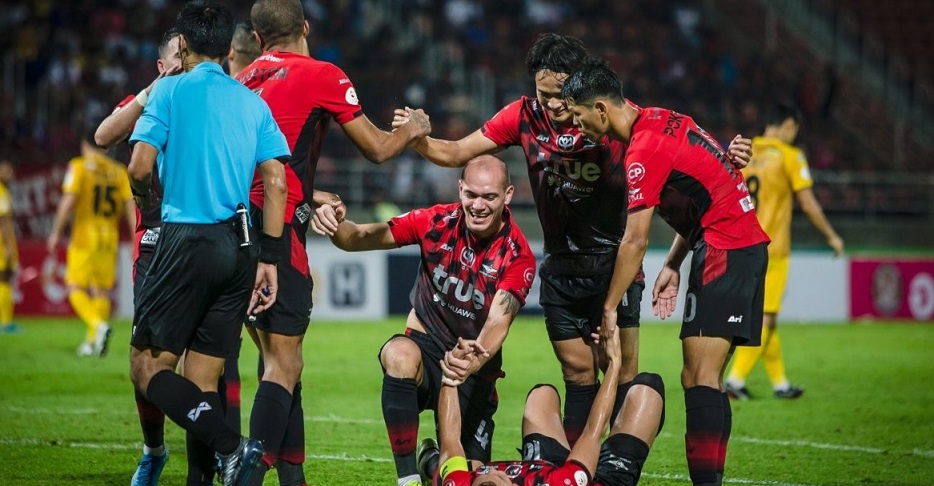
The shirts were paired with black shorts augmented by a red sidepanel and black socks that feature an extra fade around the calves for good measure. A striking full kit for sure, and one that is identifiably Bangkok United. Sadly, in the league a black nameset is used rather than one in silver – so much effort in keeping all the other printing silver, only to then trip at the final hurdle.
But was it a succesful shirt? Will we remember it for heroics on the field, or will the memory of the 2019 design need to linger based purely on its aesthetic qualities? As it turns out, despite this being the best shirt in years, it has cruelly been tied to the worst league campaign since 2015. The Angels finished fourth, behind first-time champions Chiangrai United, Buriram United, and Port FC. In the FA Cup, eventual champions Port proved too strong on penalties whilst in the League Cup Buriram squeezed past Bangkok in extra time in the quarter finals.
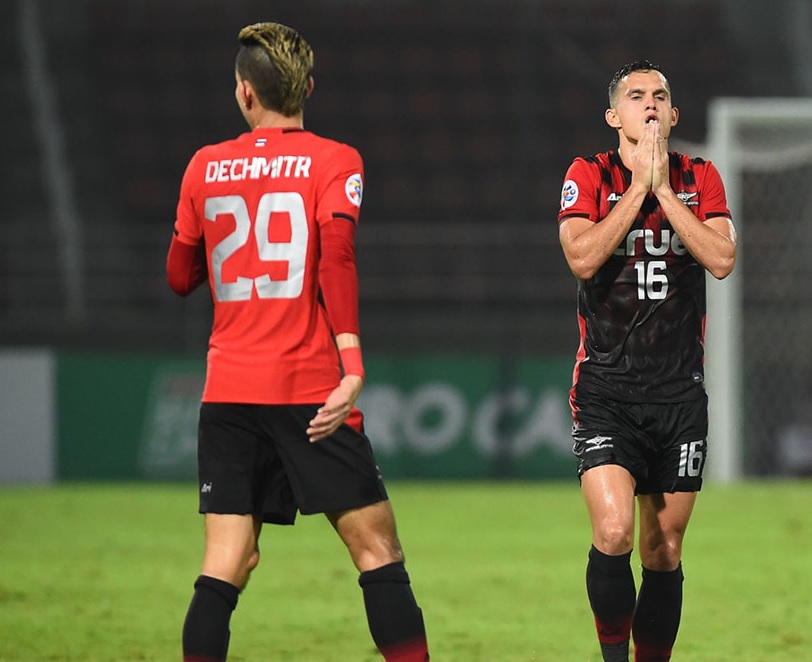
Of course, because the club had finished second in 2018, they were given the opportunity to navigate the AFC Champions League play-offs in 2019. Entering in the second preliminary round, the Angels were matched to Hà Nội of Vietnam and, surprisingly, lost 0-1 at home. This meant immediate elimination, as the prelims are across just a single game rather than based on a double round robin format. This meant that the shirts only got a single outing – with excellent silver rather than black namesets – on the continental stage. Pay attention to how all sponsors except True were removed from the shirts in keeping with the AFC’s policy on sponsorship
The board nonetheless retained faith in manager Alexandré Pölking, who had been in charge since 2014, and built towards the 2020 season with the weight of an expectant fanbase on their shoulders. Of course, the COVID-19 pandemic reered its ugly head causing postponement of the season in March, which ultimately ran from September 2020 to March 2021 (so not quite following a traditional European season calendar, considering the early finish).
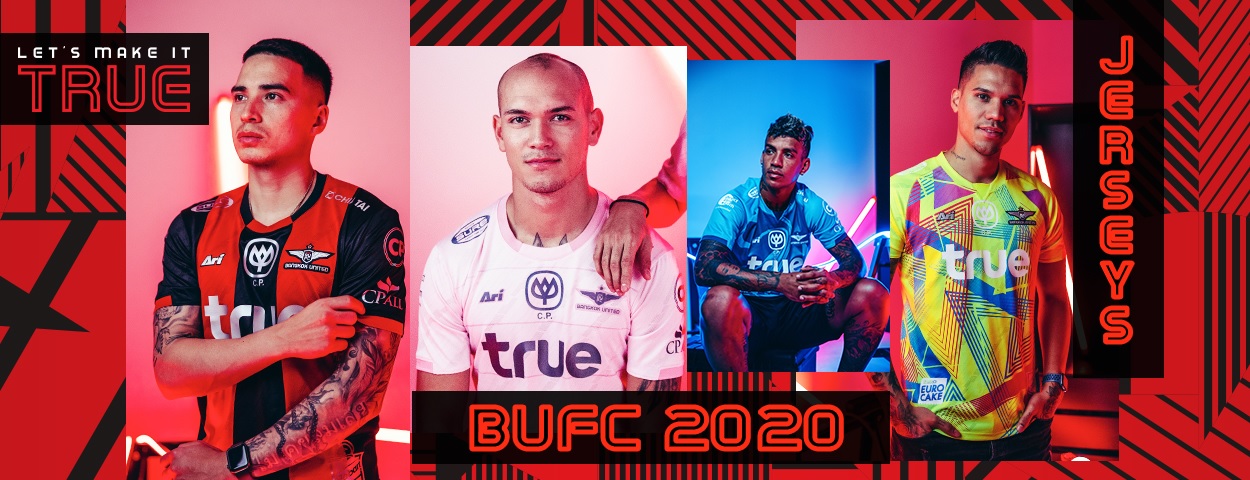
When the new season finally kicked off, United hoped to make their dreams come ‘True’ (hah) in a trio of new shirts by Ari, which includes an okayish light pink away, a pretty damn gorgeous water-inspired blue third (not very clearly visible here), and a pretty restrained home shirt that now features a central stripe and black sleeves.
Now, the club isn’t exactly known for stripes making this quite a novel new home design, but it doesn’t quite reach the lofty heights that the 2019 shirt soared to. Because, for better or worse, it was extremely unique as we hope we’ve been able to show you today. The jagged, fading checkerboard might not have lasted for more than a single season, but we sure are glad we got our hands on it all the same.
That’s just about all you need from us for now, but as always, we would like to remind you that Club 25 is a weekly publication – expect a brand new article from us next week, so keep checking back for when we have a new shirt going live. Additionally, keep up to date with us on our Twitter page and flick through the site’s Shirt Archive to see what shirts we’ve covered in the past.
